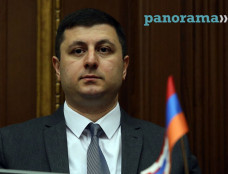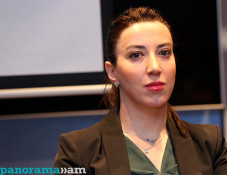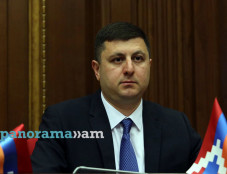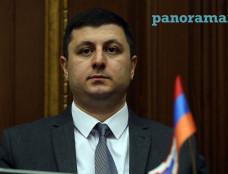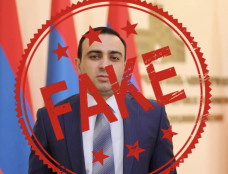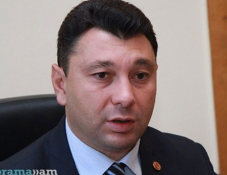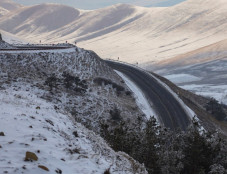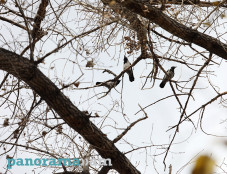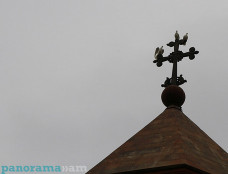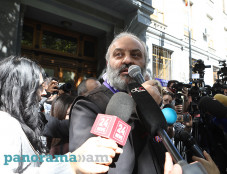
English Wikipedia publishes all contradictions about Azerbaijani fake hero Ahmadiyya Jabrayilov
The editors of the English Wikipedia, the online encyclopaedia, have added the following note to the article about Ahmadiyya Jabrayilov, a ‘legend of the French Resistance and Charles de Gaulle’s friend’: “The truthfulness of this article has been questioned. It is believed that some or all of its content may constitute a hoax.”
In particular, the editors have compiled and published all the variations of Jabrayilov’s biography, thus showing the incompatible contradictions, which brought about suspicions over the truthfulness of the heroic past of the Azerbaijani agronomist.
In 1960, the Soviet newspaper Nedelya published the following version of the biography of Jabrayilov (author – Azerbaijani historian Garash Madatov). Wounded, Jabrayilov was taken hostage by the Germans, after several failed attempts he managed to flee from the German camp. In August 1944, Jabrayilov was told by the leadership of the French Resistance to organise an escape from the camp of the town of Rodez that contained several thousands of Azerbaijanis, however on 15 August, a traitor exposed that plot to the Germans. While the plotters where being transported to the execution yard, several of them managed to escape. Later the plotters joined the Soviet partisan regiment and formed a task unit that together with the French patriots liberated the town of Rodez from the German occupation. For the participation in the Resistance movement, Jabrayilov was awarded seven French medals.
The same author, Garash Madatov, in the book ‘Azerbaijan in the Great Patriotic War’ puts the biography of Jabrayilov the following way: Participated in the Resistance since its inception, liberated Paris from the Nazis and was awarded the highest French order. On 20 August 1944 at a rally in the liberated Paris (Paris was liberated on 25 August 1944) Jabrayilov delivered a speech on behalf of the Soviet soldiers.
In the newspaper ‘Bakinskiy Rabochiy’ (Baku Worker) of 1966, the biography of Jabrayilov is presented the following way: Was taken hostage in the area of Kharkov-Izyum. Attempted to escape. Was placed in a camp near Lvov under the number 4167. Transiting through Germany he reached France. Several times tried to escape, was caught. In a camp in Toulouse, where he was again numbered 4167, a French cleaning woman Jeanne pitied Jabrayilov and persuaded the commandant of the camp to bury him in a decent way. A German doctor noticed that Jabrayilov was still alive, but allowed the funeral, hoping that he would die underground. Jabrayilov was buried alive in a coffin, at midnight French partisans dug up the coffin and pulled Jabrayilov out while he was still alive. Jeanne linked Jabrayilov with the Delplanque detachment (underground name of Dumas), together with other soldiers of the detachment Jabrayilov participated in a number of combat operations, blew up trains and bridges, foiled the plans of sending the French to labour camps in Germany. In course of one of such combat operations Jabrayilov, disguised in German uniform, was wounded and fell to the Germans, who took him for one of their own and placed him in a hospital. Having regained consciousness, Jabrayilov escaped from the hospital. During the liberation of Bordeaux (liberated on 28 August 1944) Jabrayilov, within the Delplanque detachment, led a group that penetrated into the centre of the city through the sewers and caused panic among the Germans. Later, together with the Delplanque detachment, Jabrayilov went to Paris, where he met with the leader of the Communist Party Maurice Thorez and addressed the French people at a rally. Maurice Thorez awarded Jabrayilov with the highest French decorations - the ‘War Cross’ (Croix de Guerre), the ‘Medal for voluntary military service’ and the ‘Military Medal,’ which, according to Thorez, ‘enabled Jabrayilov to march at the parades ahead of the French generals.’ During the surrender of Germany, Jabrayilov was in Paris, he then returned to his native Azerbaijan.
According to the book ‘Ever living traditions’ (Baku, 1968) by Makeev N. Y., Jabrayilov in France fought within ‘the first Soviet partisan division,’ with which he liberated Paris. In total, Jabrayilov was awarded 8 highest orders and medals of France, this constituting the fourth version of his biography.
In the book ‘Against the common enemy’ (1972), Jabrayilov describes his own biography the following way (the fifth version): In 1942 he was captured and in September 1942 was placed in a camp in the city of Montauban, where death-marked Jabrayilov was pitied by a French cleaning woman Jeanne. She persuaded the commandant of the camp to bury Jabrayilov outside the camp, however what was eventually buried was an empty coffin, while Jabrayilov was hiding in a haystack. Then, late fall of 1942, he joined the squad Delplanque in the Tarn and Garonne, as a member of which he was blowing up bridges and trains transporting the Germans and carrying out other daring combat operations. Jabrayilov’s fame resounded throughout France. Being wounded, disguised in the German uniform, he was taken to a German hospital, but escaped shortly. In mid-August 1944 Jabaryilov was in Paris, where he participated in the liberation of the city. Was wounded. After the liberation of Paris (August 25, 1944) was eager to keep fighting, but the French insisted that he completed his treatment in a sanatorium. Upon his return to the squad after completing his treatment, Jabrayilov with the Delplanque detachment participated in the liberation of Bordeaux, manoeuvring through the sewers right to the town centre and striking the Germans behind their lines. In September 1944, he participated in the liberation of Dijon, blowing up ammunition and fuel depots on the outskirts of the city, while his friends stormed the city. Later, also with the Delplanque detachment, he fought near Colmar and Strasbourg. He then returned to Paris, where he met Maurice Thorez. Was awarded five medals, ‘War Cross’ (Croix de Guerre), ‘Cross for Military Valour,’ ‘Insignia for the Military Wounded,’ ‘Partisan Medal’ and the ‘Medal for personal bravery in combat.’
B. Karpov related the sixth variant of the ‘heroic biography’ in his article ‘He fought for France,’ published in the ‘Soviet Military Review’ journal in 1975. According to the article, Jabrayilov was placed in a camp near Montauban under the number 4167. A French woman, Jeanne, saved dying Jabrayilov burying an empty coffin instead of his body. Jabrayilov joined the French partisans, and carried out numerous dangerous combat operations with them. Next the story with the sewers and striking behind the lines of the enemy comes; still in this case, it was the city of Toulon that they liberated. Jabrayilov has also taken part in the liberation of Lyon, Marseille, Toulouse and Paris. In 1945, Maurice Thorez invited Jabrayilov to his home and awarded him with orders and medals on behalf of the French government.
According to the Azerbaijani Soviet Encyclopaedia, Jabrayilov was captured in May 1942 in course of the battle for Donbas, was kept in Dachau and Alsace-Lorraine concentration camps, in November 1942 fled to join the partisans in France – the seventh version.
The eighth story. In the newspaper Bakinskiy Rabochiy (Baku Worker), an Azerbaijani journalist and author of the book ‘Azerbaijanis in the European movement of Resistance,’ Ms. Rugiya Aliyeva writes the following story of Jabrayilov’s life: In 1942 he was taken hostage near Izyum. In 1943 he was sent to a camp in the town of Rodez together with other Azerbaijani prisoners of war. In the camp Jabrayilov was numbered 4167 and stayed there until at least the beginning of 1944. Dying Jabrayilov was saved by a French woman named Jeanne, who persuaded a carpenter to pierce holes in Jabrayilov’s coffin so that the air could go through. At night, the partisans pulled Jabrayilov out of the coffin. Together with the guerrillas, Jabrayilov accomplished unique feats, he was declared wanted and the Germans pledged a reward of 10 000 Marks and two vehicles for his head. Maurice Thorez gifted Jabrayilov a custom engraved gun. When Jabrayilov’s fame reached the Resistance leadership, Charles de Gaulle expressed a wish to meet Jabrayilov. Their meeting took place on the outskirts of Tarbes, where de Gaulle instructed Jabrayilov to perform a series of complex combat operations, which Jabrayilov carried out flawlessly. After the liberation of Paris, de Gaulle invited Jabrayilov to a banquet to celebrate the liberation of the French capital. At that banquet Jabrayilov was seated directly to the right of Charles de Gaulle. Jabrayilov was awarded the title of the ‘National Hero of France’ and the Legion of Honour, which allowed him to march at the parades ahead of the French generals. During his visit to the USSR in 1966, de Gaulle wanted to visit Jabrayilov’s home in his village of Sheki, but the Soviet leadership decided to send Ahmadiyya to Moscow instead. In the Sheremetyevo airport de Gaulle saw Jabrayilov, breaching diplomatic protocol he embraced Ahmadiyya and invited him to his Moscow residence. De Gaulle offered Jabrayilov property in France and cars as a gift, but Ahmadiyya rejected the kind offer. In November 1990, the French Senate invited Jabrayilov to France to take part in the celebration of the 100th anniversary of Charles de Gaulle.
According to the ninth version by the Translation Centre of the Cabinet of Ministers of Azerbaijan, Jabrayilov was a prisoner of war numbered 4167 and was placed in the camp near Marseille, which he fled to join French guerrillas. In course of one of the combat operations, dressed in a German uniform, Jabrayilov was wounded and taken to a German hospital. Upon recovery, he was appointed commandant of the city of Albi, where he remained for eight months, gaining respect and credibility among his superiors and subordinates. Jabrayilov’s actions to rescue prisoners of the concentration camps caused the admiration of de Gaulle. After the war Jabrayilov, ‘one of the most respected members of the Union of Veterans of the Resistance’ and ‘a legend of the Resistance,’ married a French woman, with whom he had two children, and worked in the office of Charles de Gaulle. In Dijon, an automobile factory was named after Jabrayilov. However, in 1951, Jabrayilov decided to return to the USSR. The United States offered ‘the famous reconnaissance man’ American citizenship, France offered to gift Jabrayilov the factory named after him, but Jabrayilov rejected the offers. Upon his return to his native village Okhud, he barely managed to avoid the arrest and was forced to work as a shepherd. A two-part film dedicated to Jabrayilov’s life is being made in France.
The article also includes another story told to the Azerbaijani media representatives during a meeting by Javanshir Jabrayilov, Ahmadiyya Jabrayilov’s son, who heads the museum dedicated to his father’s life. Javanshir brought another evidence of the friendship between Jabrayilov and de Gaulle – a story told by Ahmadiyya and his partisan friends. According to Jabrayilov’s story, one day, during their walk in Paris, Charles de Gaulle and Jabrayilov were approached by a person in hijab, and Jabrayilov hit that person. In response to de Gaulle’s indignation as to how a Muslim could raise hand against a Muslim woman, Jabrayilov tore the hijab off that person revealing that it was actually not a Muslim woman, but a German officer disguised in a hijab. De Gaulle, saved by Jabrayilov, embraced Ahmadiyya and called him ‘his son.’
The editors of the English Wikipedia also cite an episode recounted by the Azerbaijani journalist Rugia Aliyeva. According to her, the Azerbaijani director working on Jabrayilov’s biographic film, Shain Sinaria, having reviewed the documents displayed in Jabrayilov’s museum in the village of Okhud, declared that ‘the materials displayed at that museum were nothing but a lie.’
According to the English article, in the summer of 2015, the article about Jabrayilov was marked for removal in Russian Wikipedia due to total ‘absence of traces in French reliable sources.’ Military documents of Jabrayilov in the French language in Sheki museum were composed with gross grammatical mistakes and did not include any details about the military operations with his participation. The awards on the photo of Jabrayilov exhibited in the museum included medal for the First World War. During the discussions, French military archives were requested in the suggested locations of his participation in resistance movement, however they did not know anything about a man under the name ‘Ahmadiyya Jabrayilov’ and ‘Michel Akmed’ or ‘Armed.’ The only archive that confirmed Jabrayilov’s participation in the Resistance movement, Caserne Bernadotte, replied that Jabrayilov participated in the resistance movement since August 1944 and mentioned a single medal – jubilee ‘Medaille commemorative de la Guerre 1939–1945,’ which had been awarded to anyone having whatever relation to the resistance movement. The last stroke was the response of Tarn-et-Garonne department (there, according to Jabrayilov, he joined the Resistance movement): ‘Ahmadiyya Jabrayilov... never mentioned, not listed among those decorated with medals of Resistance movement.’
In conclusion, the authors of the English article cite the Russian historian Aleksei Baikov who notes that the official version of the events of the Second World War was heavily mythologised in the Soviet Union and the debunking of the false heroes, including investigation of the Russian Wikipedia page about Jabarayilov’s life, are very useful initiatives from the factual point of view.
The article about Ahmadiyya Jabrayilov was removed from the French and Russian Wikipedia pages due to the contradictions between the numerous sources and source documents about his official biographies, a step described by the Azerbaijani media as ‘a part of a years-long conspiracy of Armenians and pro-Armenian editors against Azerbaijan.’
Related news
Newsfeed
Videos






